Potřebujeme váš souhlas k využití jednotlivých dat, aby se vám mimo jiné mohly ukazovat informace týkající se vašich zájmů. Souhlas udělíte kliknutím na tlačítko „OK“.
ASTM D5591-04(2011)
Standard Test Method for Thermal Shrinkage Force of Yarn and Cord With a Thermal Shrinkage Force Tester
Automaticky přeložený název:
Standardní zkušební metoda pro Termozmršťovací Force příze a kabel S Termozmršťovací Tester Force
NORMA vydána dne 1.1.2011
Informace o normě:
Označení normy: ASTM D5591-04(2011)
Poznámka: NEPLATNÁ
Datum vydání normy: 1.1.2011
Kód zboží: NS-31800
Počet stran: 4
Přibližná hmotnost: 12 g (0.03 liber)
Země: Americká technická norma
Kategorie: Technické normy ASTM
Kategorie - podobné normy:
Anotace textu normy ASTM D5591-04(2011) :
Keywords:
thermal shrinkage force, tire cords, yarn, Calibration--textile analysis instrumentation, Oven temperature, Shrinkage--textile fabrics/fibers, Testing methods--textile applications, Thermal shrinkage force, Tire cords and tire cord fabrics, Yarns, ICS Number Code 59.080.01 (Textiles in general)
Doplňující informace
| Significance and Use | ||||||||
|
This test method may be used for the acceptance testing of commercial shipments of yarns and cords. If there are differences of practical significance between reported test results for two laboratories (or more), comparative tests should be performed to determine if there is a statistical bias between them, using competent statistical assistance. As a minimum, test samples should be used that are as homogeneous as possible, that are drawn from the material from which the disparate test results were obtained, and that are randomly assigned in equal numbers to each laboratory for testing. Other materials with established test values may be used for this purpose. The test results from the two laboratories should be compared using a statistical test for unpaired data, at a probability level chosen prior to the testing series. If a bias is found, either its cause must be found and corrected, or future test results for that material must be adjusted in consideration of the known bias. Experience shows that yarns or cords on would packages, usually being under tension, exhibit a contraction in length (and a resulting increase in linear density) when removed from the package and allowed to relax over a period of time at room temperature. Consequently, it they are tested without being allowed to relax, they will register higher thermal shrinkage force values as the relaxation shrinkage will be incorrectly included as the thermal shrinkage force. Retractive forces vary widely by polymer type, being almost nil within aramids and significant within most nylons. For example, the exposure of untensioned skeins of nylon yarn or cord to 95 to 100 % relative humidity at room temperature for two days and reconditioning under standard laboratory conditions will cause most of the length change that is possible at room temperature to occur within a sample. This reduction in length is accompanied by some lowering of thermal shrinkage force. The thermal shrinkage force of nylon, polyester, and aramid fiber is related to the polymer of origin and its manipulation in processing. Thermal shrinkage force measurement can be used to control product uniformity. The level of thermal shrinkage force is critical in the user's subsequent operations, such as the drum-set (original length of cord) required to build a tire of a particular size. The thermal shrinkage force is critical to the final shape and size of fiber-reinforced articles. For example, thermal shrinkage force affects the final size of V-belts and their ability to maintain tension during their operation. This test method is in agreement with the nominal procedures of Methods D885 for the determination of thermal shrinkage force in yarns and cords. Shrinkage force is measured while the specimen is within an oven at a specified temperature and after a specified length of time. |
||||||||
| 1. Scope | ||||||||
|
1.1 This test method covers preparation and procedures to measure the thermal shrinkage force of yarns and cords in air. 1.2 This test method is applicable to measurement of the thermal shrinkage force of yarns and cords whose shrinkage force at 180 ± 2°C (355 ± 4°F) in air does not exceed 20 N (4 lbf). This test method is applicable to nylon, polyester, and aramid yarns and cords within the applicable range of thermal shrinkage force, as well as to comparable yarns and cords from other polymers. 1.2.1 Test specimens may be taken from yarn or cord packages, or retrieved from fabrics. 1.3 The values stated in SI units are to be regarded as the standard. The values given in parentheses are for information only. 1.4 This standard does not purport to address all of the safety concerns, if any, associated with its use. It is the responsibility of the user of this standard to establish appropriate safety and health practices and determine the applicability of regulatory limitations prior to use. Specific hazards statements are given in Section 8. |
||||||||
| 2. Referenced Documents | ||||||||
|
Podobné normy:
Historická
15.5.2014
Historická
1.6.2012
Historická
1.7.2013
Historická
1.6.2010
Historická
1.12.2012
Historická
1.6.2013


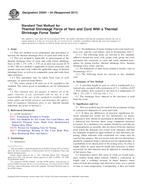
 ASTM D3136-14
ASTM D3136-14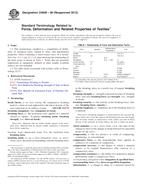 ASTM D4848-98(2012)..
ASTM D4848-98(2012).. ASTM D4920-13
ASTM D4920-13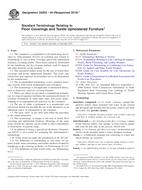 ASTM D5253-04(2010)e..
ASTM D5253-04(2010)e..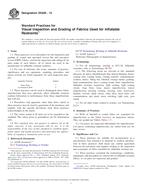 ASTM D5426-12
ASTM D5426-12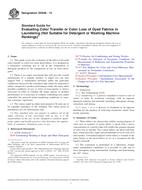 ASTM D5548-13
ASTM D5548-13
 Cookies
Cookies
